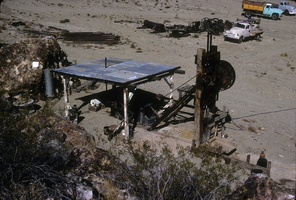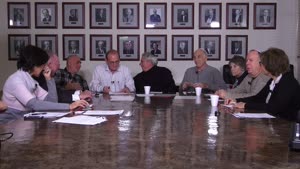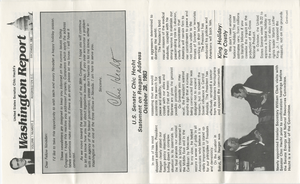Search the Special Collections and Archives Portal
Search Results
C. Vern Olmstead Professional Papers
Identifier
Abstract
The C. Vern Olmstead Professional Papers (1940-1975) contain materials related to Olmstead’s work as a prominent meat industry executive. The collection pertains to the preparation, cutting, storage, marketing, and distribution of meats including beef, pork, and poultry. Materials include reports, correspondence, newspaper and magazine clippings, photographic prints and slides, and publications regarding topics relevant to the handling and sale of meat in the United States and Canada.
Archival Collection
Ronnow Family Photographs
Identifier
Abstract
The Ronnow Family Photographs contain four black-and-white photographic prints of the Ronnow family in Southern Nevada from approximately 1870 to 1950. Also included is one large oversized black-and-white photographic print of the Old Rotary Club with C. C. Ronnow present.
Archival Collection
Ladies Auxiliary to the Veterans of Foreign Wars Collection
Identifier
Abstract
The Ladies Auxiliary to the Veterans of Foreign Wars Collection (1951-1977) contains publicity books, scrapbooks, community service records, newspaper clippings, correspondence, photographs, and newsletters pertaining primarily to the Fred S. Pennington post no. 1753 Ladies Auxiliary to the Veterans of Foreign Wars of Las Vegas, Nevada and the associated local chapter of the American War Mothers organization. The Ladies Auxiliary and the American War Mothers are non-profit organizations that assist in providing support and services to veterans and active service members. This material was formerly known as the Luanna Mitchell Collection.
Archival Collection
Oran K. Gragson Papers
Identifier
Abstract
The Oran K. Gragson Papers (1955-1998) contain former Las Vegas, Nevada Mayor Oran K. Gragson's professional and personal papers, and include correspondence, files concerning Gragson's tenure as Mayor of Las Vegas, Nevada, arbitration documents from disputes between labor unions and Las Vegas casinos, committee notes, financial plans, and documents from Clark County and Las Vegas government departments. The collection also contains city development plans, environmental reports, political party documents, memorabilia, ephemera, photographs, awards, newspaper clippings, and scrapbooks.
Archival Collection
Elizabeth Harrington Collection of Essays
Identifier
Abstract
This collection contains the original drafts of the thirteen essays that Elizabeth Harrington wrote about her life in early Las Vegas, Nevada. These articles were written from her memory and experiences of life in Las Vegas beginning in the early 1900s, and were published in the Nevadan section of the Las Vegas Review-Journal from 1975-1979.
Archival Collection

Paul Sogan interview, May 16, 1995: transcript
Date
Archival Collection
Description
Interviewer: Dennis McBride
Text

Slide of the old stamp mill, circa 1950s
Date
Archival Collection
Description
Image

Transcript of interview with Sarah Haggerty and Lancy Kirk by Claytee D. White, February 2, 2010
Date
Archival Collection
Description
Text

Video, Roundtable discussion with members of Temple Beth Sholom, January 14, 2015
Date
Archival Collection
Description
In this roundtable discussion video, members of Temple Beth Sholom discuss the history of the long-established congregation. Interviewees are Sandy Mallin, Oscar Goodman, Jared Shafer, Joel Goot, Arne Rosencrantz, Jerry Blut, Jackie Boiman, Gene Greenberg, and Flora Mason, with Shelley Berkley joining in later in the interview. Most of the interviewees have been involved in the leadership of the congregation. They discuss relationships with various rabbis over the years, and successful fundraising efforts to build the original synagogue. Other early leaders in the congregation were Edythe Katz-Yarchever, the Goot family, Stuart Mason, Herb Kaufman and Leo Wilner. Until the 1980s, Temple Beth Sholom was the only synagogue in Las Vegas, but after a dispute over the burial of a non-Jew, a new synagogue formed (Shareii Tefilla), and at nearly the same time, Temple Beth Sholom began investigating a move from their site on Oakey Boulevard. Most have nostalgia for the former location, but discuss the changes in the neighborhood that necessitated the move to Summerlin. Then they discuss the other initiatives that were borne out of Temple Beth Sholom, such as bond drives for Israel, B'nai B'rith, and the Kolod Center. They share other memories, and discuss the leadership and Sandy Mallin becoming the first female president of the temple. They credit Mallin with keeping the temple going through lean years, and helping to recruit Rabbi Felipe Goodman. The group goes on to mention other influential members of the Jewish community including Jack Entratter and Lloyd Katz, who helped integrate Las Vegas.
Moving Image

